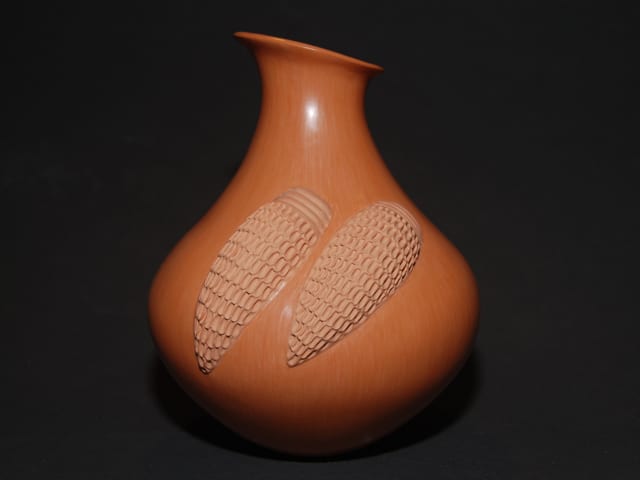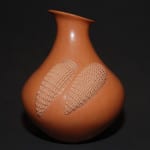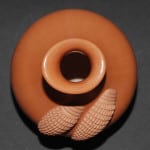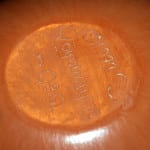Unpainted, highly burnished and kiln-fired with a sloped lip and graceful shape, the pot is of a style unique to “Al Q.” Note that the ears of corn are formed by pushing the wet clay from the inside and then carving the raised external clay.
Born in 1938 and raised in Los Angeles by Hopi parents who had left the reservation, Al writes:
“I am of the second generation of Hopi beyond the broken pattern, a way of life totally foreign to the western world. With the full influence of western civilization, I am the product of two worlds…. Through the patient hand and guidance of a beautiful teacher, my aunt Polingaysi, I learned the basic techniques and philosophy I now use in my pottery creations. My clay creations reflect the aesthetic influences of the southwest environment and values passed down through our family…. At the same time my respousse technique provides a unique “contemporary” style of ceramics. I am not restricted by a particular tradition, rather I’m free to innovate.”
For extensive comments by Al Q concerning his aesthetic journey, see the show catalog Qoyawayma, (1984). According to the catalog, Al Q and his aunt Polingaysi in the early 1960s began using a corn motif formed by pushing the pliable clay out from the inside of the pot. In 1975 they saw an exhibit at the Field Museum and were surprised to find that a similar technique had been used to form corn on Ecuadorian pots almost 5,000 years ago (1984: 29).
Qoyawayma is of the Coyote Clan, the original inhabitants of the village of Sikyatki, which is source of probably the finest pottery produced in the ancient Southwest. Qoyawayma, a mechanical engineer, did not begin to experiment with pottery until the 1960s. He was initially taught by his aunt, Polingaysi (see 2005-08) who approved of his effort (“You’ve got it!”) in 1966; ten years later he had his first solo exhibit. The lives of the aunt and nephew are strikingly similar, as is the aesthetic of their pottery. Both Polingaysi and Al Qoyawatma developed as adults in the Anglo world and had successful Anglo careers. Both became potters as adults and turned to their Hopi roots for aesthetic inspiration. Both created elegant unpainted pots with raised images that were fired in kilns. Both produced pottery that was quickly accepted in the Anglo world as “fine art.”
Al Qoyawayma’s scientific training and Hopi pottery knowledge were the basis of his involvement in an effort by the Smithsonian Institution to determine the sources of the ancient clay beds at Sikyatki, Awatovi, and Jeddito. (See: Bishop, 1988). His pots, including 2006-03, use clay from these ancient Sikyatki sources and are traditionally hand coiled and polished, though kiln-fired.
Lee Cohen, an early supporter of Qoyawayma’s pottery style, edited a book that features Qoyawayma. “Qoyawayma’s pieces exhibit almost impossible exquisite fluidity of form as well as a pristine, sculpturally perfect classical elegance… the entire effect is one of sublime form (McCoy, 1993:81-83).” The aesthetic of Al Q’s pottery is easily accessible and the impact immediate. For a photograph of Al Qoyawayma with his pots, see Arizona Highways, (May 1986) inside cover & p.7.
Jar 2006-03 is called “gourd shaped,” but to me the shape could not be more feminine and nurturing: a womb body holding the corn precious to Hopi survival, the corn pushed out from the body of the clay (the clay giving birth to life), the womb tapering into a long neck—like a birth canal—with a sloped, flared rim. The image is sensuous, fecund, and beautiful. Like the corn it depicts, the clay is born of the earth and contains both the ground shards of ancient pots made by Qoyawayma’s ancestors and, perhaps, the dust of the ancestors themselves. Would it be possible to construct a more generative image?




